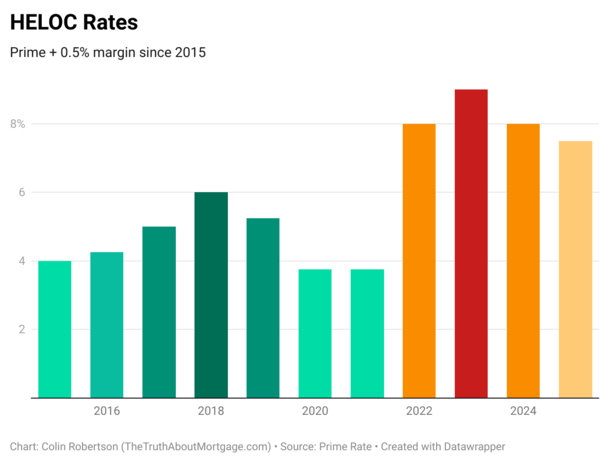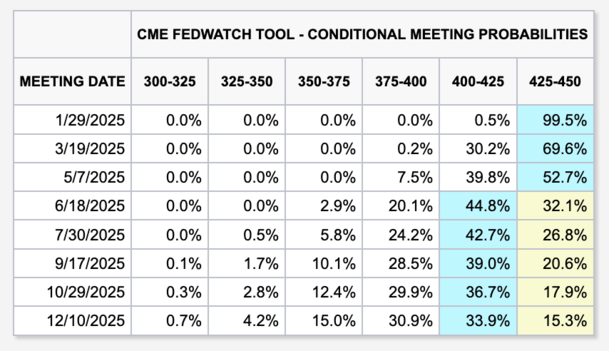HELOC Rates Expected to Continue Falling in 2025

Let’s talk about HELOC rates. If you’ve had a home equity line of credit (HELOC) for a long time, you may have seen your interest rate rise significantly over the past few years.
The reason is that HELOCs are adjustable and tied to the principal amount, which moves by capping the amount of money supplied.
Since early 2022, the Federal Reserve has raised its target rate 11 times, raising the key rate from 3.25% to 8.50%.
This means that homeowners with HELOCs saw their rates increase by 5.25% in less than two years.
But here is the good news; HELOC rates have been on the rise for the past year and the Fed has since cut rates by 100 basis points (bps), providing much-needed repayment relief in the process.
Three Fed Rate Cuts in 2024 After Series of Hikes
Although the financial markets are volatile and constantly changing, the data showed that the Fed’s rate hike was done.
And best of all, more rate cuts are on the horizon between now and the end of 2025.
The CME FedWatch tool, which tracks the likelihood that the Fed will change its target rate at the upcoming FOMC meetings, no longer has an additional rate hike as a surprise favorite.
Instead, it has low rates for several months until another 0.25% rate cut as a possible move is scheduled for the June 2025 Fed meeting.
For now, rates are expected to remain unchanged, although rate cuts may come sooner.
These percentage odds are based on the interest rate trades conducted by major dealers in the market for unsecured loans between financial institutions.
Forecasts can change (and they always do), but the data seems to suggest more along the lines of a downgrade rather than a hike.
In the chart above, you can see that the fed funds rate was expected to drop to a range of 3.75% to 4% by the end of 2024, but it didn’t drop that much.
Instead, it reached a range of 4.25% to 4.50%, which is still slightly lower and not too far from what traders were expecting.
And if the Fed cuts another 50 basis points in 2025, we’ll get to those projected levels anyway.
Depending on how things go in the economy, the rate cut could come before June, and rates could be cut more than twice this year.
The opposite is also true, which is always dangerous with variable rate loans.
HELOCs Make More Sense Than Refinancing Now
In recent years, mortgage lending has increased rapidly as interest rates on home loans have more than doubled.
Long story short, it doesn’t make a lot of sense to apply for a cash refund to lose your low fixed rate mortgage in the process.
And the economy is getting more attractive as first-time home prices rise.
At first glance, the 30-year fixed rate was around 7%, and your actual rate could be much higher if you choose to cash out (why the high repurchase rates?).
This makes it a losing proposition for many, seeing as the average American homeowner has a fixed rate in the 2-4% range.
But borrowers still want to take advantage of their piles and piles of home equity and get access to cash.
Another is a second mortgage that doesn’t affect the first mortgage, but still allows for the release of equity. Options include a home equity loan or HELOC.
With a HELOC, you get the flexibility to borrow only what you need, but the downside is an adjustable interest rate that matches the principal amount.
HELOC Rates Rise Less Than 5% Through 2022
The biggest downside to HELOCs is their variable rate. As noted, it is tied to prime. It is good if the prime is low and still.
But due to uncontrollable inflation, ironically due to excessive rates, the Fed was forced to raise the rate of fed funds 11 times since the beginning of 2022.
Every time the Fed does that, the prime rate rises by the same amount.
Currently, the prime rate is 7.50%, up from 3.25% as recently as early March 2022.
At one point in 2023, it was as high as 8.50%, so it’s 1% below its peak and it’s falling even further, eventually.
Consider the homeowner who originally took out a HELOC when the prime rate was 3.25%. Maybe their rate was as high as .50%, or 3.50%. That is an advantage.
But today they will be paying 8% interest (7.50% + 0.50%) on their HELOC. Wow!
The good news is that the worst is probably behind us. But currently the monthly HELOC payment is much higher than before, especially if it is tied to a large balance.
And it’s likely that many homeowners rely on them to finance various home improvement projects that can run into six figures.
Your HELOC rate depends on the Prime, Margin, and any Discounts

The chart above shows the movement of the prime rate, which is what all HELOCs are based on.
To come up with your actual HELOC amount, margin is added. This is basically a mark more than the amount the bank takes as profit.
So with a prime rate currently at 7.50%, you can get an 8% rate if the 0.5% margin is factored in.
But these margins can vary greatly from bank to bank, especially if you have relationship discounts as an existing customer.
For example, if you are already a customer at the bank and use automatic payment, they can offer you discounts of .50% to .75%.
That can lower your HELOC rate very close to or even below for a certain period of time, assuming you have excellent credit and a low combined loan-to-value (CLTV) ratio.
Or the margin can be 1% or more, which means an 8.50%+ rate on your HELOC.
Similar to original mortgages, there may be price adjustments on HELOCs for things like FICO score, CLTV, property type, and so on.
If you are a very low risk borrower with an existing relationship you should qualify for the best HELOC rates. This may reach your rate at or near prime.
Learn more about how to compare HELOCs from bank to bank.
HELOC Interest Rates Could Be Another 0.5% Lower by the End of 2025

Using the CME FedWatch table from above, the fed funds rate could end in 2025 in a range of 3.75% to 4.00%, which is about 0.5% below the current range of 4.25% to 4.50%.
Because the prime rate is determined by the Fed’s rate hikes and cuts, that will lower HELOC rates by the same amount, and then another 0.5% if these constraints are successful.
It may not mean much relief, but it can be some relief. And the monthly payments will start to come down for many homeowners who hold these variable rate second mortgages.
HELOC rates are determined by combining a pre-set fixed margin with the principal amount, which we know can go up or down.
So our hypothetical borrower with a 0.5% rate has a HELOC rate of 8%, which includes a current principal amount of 7.50%.
If this rate cut happens, and the prime rate falls to 7%, it will eventually be worth 7.50%.
HELOC Payments Will Fall When Prime Rates Go Down
If you have a HELOC, you should focus on Fed rate cuts. After all, it will result in a lower monthly payment and less interest due on the HELOC.
And maybe peace of mind to see the pay fall as opposed to the change rise.
Rates may continue to decline until 2025 if further reductions are warranted based on economic conditions.
So when shopping for a HELOC, consider the fact that rates (and payments) will likely drop over the next year.
This may influence your decision to go with a HELOC instead of a fixed rate loan.
One good thing about a HELOC is the fact that you don’t have to take out the full amount of the line at first.
You can open one and make a small estimate if you think prices will be negative for the foreseeable future. Then you can access more money later when HELOC rates have come down again.
What About Mortgage Rates and Fed Rate Cuts?
Although the rate of supply of funds does not determine loan rates, it can play an indirect role.
Simply put, if the rate of money supply begins to decline because the economy is slowing down, it may indicate long-term low rates over time.
That could lead to a 30-year low, as a cooling economy and inflation could lower 10-year bond yields that are tied to mortgage rates.
In addition, more optimism from the Fed could result in a widening of the subprime mortgage rate, which has doubled in recent years.
So we might conclude that original loan rates, as well as HELOC rates, are already too high.
Of course, mortgage rates may take time to come down and may remain “stuck” at these new high rates.
However, any relief is welcome after seeing mortgage rates exceed 8% by the end of 2023.
While there’s a good chance we’ve already seen higher interest rates this cycle, there’s still reason to be cautious as economic data continues to pour in.
Any surprises could upset these current estimates, even though they seem to be moving in the right direction.
Read on: Three differences between HELOCs and home equity loans.
Source link



